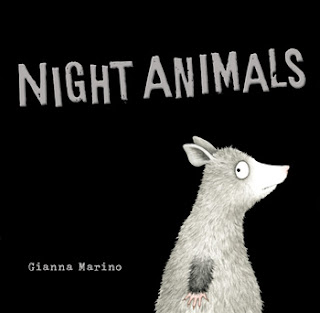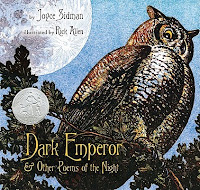Forest Bright, Forest Night, written by Jennifer Ward and illustrated by Jamichael Henterly, is a short rhyming text that explores the daytime forest from the front, and then when the book is turned around and flipped upside down, explores the nighttime forest from the back. Sandwiched between these two sections is a page of informational text that explains what animals do by day (or night) and what an animal counterpart is doing at the same time. The illustrations will certainly capture the attention of readers, as Henterly has cleverly hidden animals throughout the pages.
The daytime section begins this way:
Sun light, forest bright,
After sleeping through the night,
Leap and flash . . . deer splash
Climb and stumble . . . bear cubs tumble
In the illustration for the deer page, readers will find the number one cleverly "etched" into the tree with an owl fast asleep in the branches. In the illustration for the bear page is the number 2 and two porcupines can be found sleeping inside holes in the tree. The counting aspect to the illustrations will give readers something extra to look for as they read the simple text.
This section ends with these words:
Sun sinks,
Moon winks,
Hello, forest night.
The informational text that accompanies day describes the animals found in the illustrations.
By day...
While a deer leaps through the forest, an owl sleeps in a tree.
While bears climb and tumble, porcupines sleep in a tree or burrow.
The nighttime section begins this way:
Moon bright, forest night,
After sleeping through the light,
Hoot and perch . . . owl eyes search
Parade and plod . . . porcupines trod
The counting format holds true in this half of the book as well, with the the number one cleverly "etched" into a stone on the owl page with a deer fast asleep on the forest floor. In the illustration for the porcupine page, two porcupines walk over a den in which a pair of bear cubs slumber.
This section ends with these words:
Moon goes down,
Sun grows round,
Hello, forest day.
The informational text that accompanies night also describes the animals found in the illustrations.
At night...
While an owl is awake and hooting, a deer sleeps in a thicket.
While porcupines plod around the forest, bears sleep in a den.
There is a wonderful symmetry to this book and a good deal of information about nocturnal and diurnal animals. Readers will learn that in the forest, no matter the time of day, some animal is awake while another is asleep.
The simple text of FOREST BRIGHT, FOREST NIGHT makes it a good book to start with. Many of the animals in the illustrations are described more fully in Sidman's poems and Allen's illustrations. In reading through the FOREST NIGHT half, I would stop periodically to include Sidman's poems and informational text.
For additional resources, consider these sites.
Finally, for a bit of fun, consider adding this book to your reading list.
Good-Night Owl, written and illustrated by Pat Hutchins, opens with an owl trying to sleep up in a tree. While trying to, owl is disturbed by the sounds that the animals around it begin to make. First, it's the bees that “buzz, buzz.” Then comes the squirrels that “crunch, crunch,” on nuts. A total of ten different creatures, from jays to cuckoo to doves, disturb owl during the day. At the end the when “the moon came up,” the “Owl screeched, screech screech, and woke everyone up.”












